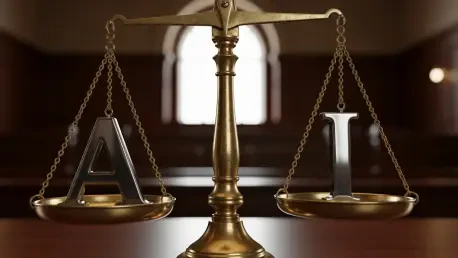In a development that has sent shockwaves through the legal community, U.S. District Judge Henry T. Wingate in Mississippi has publicly acknowledged that his staff employed artificial intelligence (AI) to draft a court order that was later found to be riddled with significant errors, casting a spotlight on the intersection of technology and the judicial system. This revelation, emerging from a detailed report published recently, raises pressing questions about the reliability of AI tools in environments where precision is paramount. The flawed order, which temporarily halted a state law banning diversity, equity, and inclusion (DEI) programs in public schools, included incorrect references to parties, misquotations of the law, and even cited a nonexistent legal case. As AI becomes increasingly integrated into professional spheres, this incident underscores the potential pitfalls of unchecked reliance on such technology, prompting a broader discussion about accountability, ethical standards, and the urgent need for regulatory frameworks in the judiciary.
Unpacking the Judicial Error
The incident that brought this issue to light occurred when a law clerk under Judge Wingate used an AI tool named Perplexity to draft a court order issued on a significant date earlier this year. This order, intended to pause enforcement of a Mississippi state law, was marred by glaring inaccuracies that quickly drew attention from the state’s Attorney General’s Office. The mistakes were so severe that the original document was replaced with a corrected version and removed from public access, initially without explanation. What was first described as a simple clerical error later revealed a deeper issue: the unverified use of AI-generated content. This lapse in oversight not only compromised the integrity of the judicial process in this specific case but also highlighted the risks of adopting advanced tools without proper safeguards, setting a precedent for scrutiny in similar scenarios across the legal field.
Further examination of the situation reveals the complexities of integrating technology into high-stakes environments like federal courts. The AI tool, while designed to assist with efficiency, produced content with what experts term “hallucination”—fabricated or incorrect information presented as fact. In this instance, the errors included misrepresentations of legal citations and parties involved, which could have had serious implications for the case’s outcome if not caught. The subsequent correction of the order, though necessary, did little to mitigate the initial damage to credibility. This event serves as a cautionary tale, emphasizing that technology, no matter how promising, cannot replace the meticulous human review required in judicial proceedings. It also raises the question of how such tools are vetted before being utilized in contexts where accuracy is non-negotiable.
Challenges of Transparency in the Judiciary
Transparency, or the lack thereof, has emerged as a central concern following Judge Wingate’s delayed admission of AI involvement in the drafting error. Initially, the judge downplayed the inaccuracies as minor clerical oversights and refrained from reinstating the flawed order to the public docket, citing potential confusion. This decision, however, fueled speculation and eroded trust among legal observers and the public alike. Only after sustained external pressure, including an inquiry from a prominent Senate Judiciary Committee member, did Wingate formally acknowledge the use of AI in a detailed correspondence to the Administrative Office of the Courts. This hesitation to disclose critical information promptly suggests a gap in the mechanisms meant to ensure openness, prompting calls for stricter protocols on how judicial errors are communicated and addressed in the digital age.
Beyond the immediate incident, the broader implications for public trust in the judiciary cannot be overstated. When errors occur, especially those involving emerging technologies, the expectation is for swift and candid acknowledgment to maintain confidence in the system. The delay in this case has led to debates about whether current practices adequately protect the public’s right to know about procedural missteps. Legal scholars argue that transparency is not just about admitting fault but also about demonstrating accountability through corrective actions and public dialogue. As technology continues to shape judicial processes, establishing clear guidelines for disclosure will be crucial to prevent similar situations from undermining faith in the legal system. This case illustrates that silence or delayed responses can often exacerbate skepticism more than the error itself.
Navigating the Dual Nature of AI in Legal Settings
The growing adoption of AI in the legal profession presents both remarkable opportunities and significant risks, as vividly demonstrated by this incident in Mississippi. Tools like Perplexity promise to enhance efficiency by automating tasks such as research and drafting, potentially saving time and resources for overworked court staff. However, the downside is evident when these tools generate unreliable content that slips through without proper scrutiny. The phenomenon of AI “hallucination” is particularly troubling in a field where factual accuracy is the bedrock of justice. Without established guidelines for AI use in federal courts, the judiciary finds itself in a reactive position, grappling with how to harness technological benefits while minimizing errors that could compromise fairness in legal proceedings.
Moreover, the absence of comprehensive policies for AI integration reveals a systemic challenge that extends beyond a single judge or courtroom. Legal experts point out that while innovation is essential, it must be accompanied by rigorous training for staff and mandatory verification processes to ensure AI outputs meet the high standards expected in judicial work. The potential for efficiency must be weighed against the risk of inaccuracy, and this balance remains elusive in the current landscape. As more courts experiment with AI, the lessons from this case underscore the importance of proactive measures to address vulnerabilities. Developing a framework that prioritizes both technological advancement and accountability will be vital to prevent future missteps from tarnishing the judicial process.
Ethical Disparities and Oversight Gaps
One of the more troubling aspects of this situation is the apparent disparity in accountability between different roles within the legal system. In Mississippi, attorneys have faced repercussions for submitting AI-generated documents containing errors, with sanctions serving as a deterrent for negligence. Yet, similar mechanisms for holding judges or their staff accountable appear less defined or enforced, creating an uneven ethical landscape. This inconsistency raises fundamental questions about fairness and whether the same standards should apply across all positions in the judiciary. The lack of uniform oversight in this regard could potentially lead to perceptions of leniency or bias, further complicating efforts to maintain public trust in the system.
Adding to the complexity is the need for a cohesive approach to ethical guidelines that address the unique challenges posed by AI. While attorneys may be penalized for errors, the responsibility of judicial staff using such tools often falls into a gray area, lacking clear protocols for discipline or correction. This gap in oversight not only affects individual cases but also sets a precedent for how technology-related errors are handled at higher levels of the judiciary. Addressing this disparity requires a reevaluation of existing policies to ensure that accountability is not selective but universal. Legal reform advocates suggest that creating standardized rules for AI use, applicable to all court personnel, could help bridge this divide and reinforce the principle that no role is above scrutiny when errors impact justice.
Moving Forward with Reform and Regulation
In the wake of this troubling incident, Judge Wingate has taken steps to prevent recurrence by implementing stricter internal procedures, such as mandatory secondary reviews of all drafted documents and requiring physical copies of cited legal cases to accompany final submissions. These measures aim to ensure that errors, whether human or technology-driven, are caught before they reach the public domain. While commendable, these actions also highlight the reactive nature of current responses to AI challenges in the judiciary. They serve as a starting point, but broader systemic changes are necessary to address the root causes of such mishaps and to build a framework that anticipates rather than merely responds to technological pitfalls.
Simultaneously, calls for comprehensive reform have gained traction, with influential figures in the legal community advocating for permanent AI policies to guide federal courts. A dedicated task force, under the direction of the Administrative Office of the Courts, has already begun issuing interim guidance, urging legal professionals to verify AI-generated content meticulously. This guidance also encourages transparency about the use of such tools in court submissions. These initial steps reflect a growing consensus that adapting to technology requires deliberate and structured efforts. Looking ahead, the focus should be on developing robust regulations over the coming years, ensuring that innovation enhances rather than undermines the judicial process, and setting a global standard for how courts navigate the digital era.









